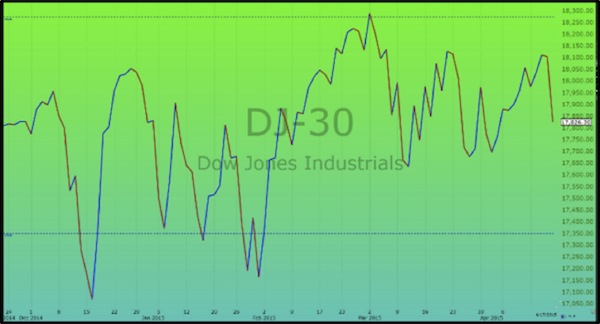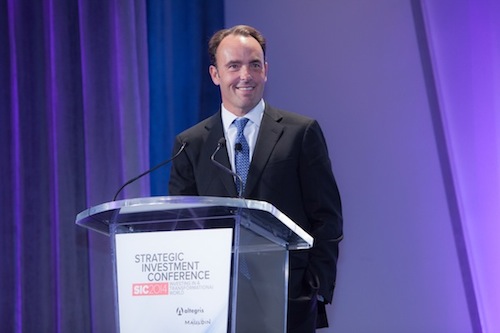Half a Stocks Bubble Off Dead Center
Stock-Markets / Stock Markets 2015 Apr 22, 2015 - 10:49 AM GMTBy: John_Mauldin
 I can sense a growing unease as I talk with investors and other friends, from professional market watchers and traders to casual observers. What in the Wide World of Sports is going on? It is not just that markets are behaving in an unusual and volatile manner (see chart below showing multiple double-digit moves in the last few months); it’s that the data seems to be so conflicting. One day we get data that shows the economies of the developed world to be slowing, and the next day we get positive numbers. The ship of the economy seems to be drifting rudderless.
I can sense a growing unease as I talk with investors and other friends, from professional market watchers and traders to casual observers. What in the Wide World of Sports is going on? It is not just that markets are behaving in an unusual and volatile manner (see chart below showing multiple double-digit moves in the last few months); it’s that the data seems to be so conflicting. One day we get data that shows the economies of the developed world to be slowing, and the next day we get positive numbers. The ship of the economy seems to be drifting rudderless.

My dad used to say about a situation that just didn’t seem quite right that things were “about a half a bubble off dead center.” (This was back in the days when we used bubble levels to determine whether something was level or plumb – before today’s fancy digital gadgets.)
There is a reason, I think, that everything seems just a little out of kilter. I believe that central banks, in their valiant, unceasing efforts to restore liquidity and growth, have unleashed numerous unintended consequences that are beginning to show up in earnest. Today we are going to review the well-meaning behavior of central banks for clues about our near future.
But first, let me take one final opportunity to invite you to come to the 2015 Strategic Investment Conference. We’ve assembled an amazing cast of speakers who will delve deeply into what is really driving the world’s economy. I have some of the finest experts on China from around the world, central bankers, some very powerful analysts whose work commands the attention of the biggest institutions and hedge funds in the world (and whose work costs 20 times or more the price of my conference). Market analysts, geopolitical wizards, and futurists will be on hand, too. This is really the finest gathering of minds I have been pleased to assemble for a Strategic Investment Conference. Click on the link above and peruse the lineup and schedule. The conference starts in a little over a week, on the evening of April 29, and lasts through May 2 at noon. Between those times we will wine and dine you as you feast on powerful ideas, one after another. You will come away with a much better grasp of our near-term future, including when and how the Fed will raise rates, what will happen to China, how Europe will evolve (or devolve), and what the overall geopolitical outlook for the world is. All in one place with some of the smartest and friendliest attendees you’ll ever find.

Almost everyone who attends these conferences say they are the best they’ve ever been to, and I work hard to make sure they can say that every year. This year I believe they will be able to say it again. Make a last-minute decision to come – you’ll be glad you did. To make your decision easier, we are holding the current registration price of $2,195 through the rest of the week.
Now let’s look at what central banks are doing to us.
A few years ago, Jonathan Tepper and I wrote a book called Endgame, in which we talked about liquidity traps developing at the end of debt supercycles. And we certainly did have a liquidity trap, all over the world. The major central banks came up with rather radical policies to deal with it, and those were necessary at the time. But then, like the proverbial Energizer Bunny, they just kept going and going and going.
Central banks have proven that they can make money cheap and plentiful, but the money they’ve created isn’t moving around the economy or stimulating demand. It’s like a car. Our central banker can put the pedal to the metal and flood the engine with gas; but because the transmission is busted, it’s hard to shift gears, and power isn’t delivered to the wheels. Without a transmission mechanism, monetary policy is ineffective. Study after study has shown that quantitative easing didn’t produce the “bang for the buck” that central bankers hoped it would. After a credit crisis like last decade’s, central bankers can cut the nominal interest rate all the way to zero and still not be able to get their economies in gear. Some economists call that a “liquidity trap” (although that usage of the term differs somewhat from Lord Keynes’s original meaning).
The Great Recession plunged us into a liquidity trap the likes of which the world hadn’t seen since the Great Depression, although Japan has been more or less mired in a liquidity trap since their bubble burst in 1989.
Economists who study liquidity traps know that some of the usual rules of economics don’t apply when an economy is stuck in one. Large budget deficits don’t drive up interest rates; printing money isn’t inflationary; and cutting government spending has an exaggerated impact on the economy.
In fact, if you look at recessions that followed on the heels of debt crises, growth was almost always very slow. For example, a study by Oscar Jorda, Moritz Schularick, and Alan Taylor found that recessions that occurred after years of rapid credit growth were almost always worse than garden-variety recessions. One of the key findings of their study is that it is very difficult to restore growth after a debt bubble.
Yet Paul Krugman took a victory lap this week on behalf of the reigning economic paradigm and its role in the US recovery. While he was at it, he chided Europe for not pursuing the same policies:
It’s true that few economists predicted the crisis. The clean little secret of economics since then, however, is that basic textbook models, reflecting an approach to recessions and recoveries that would have seemed familiar to students half a century ago, have performed very well. The trouble is that policy makers in Europe decided to reject those basic models in favor of alternative approaches that were innovative, exciting and completely wrong.
Actually the difference in the performance of the US and European economies was almost all attributable to our shale oil revolution. Without it, US growth would have been closer to 1% than our recent anemic 2% average (and likely to be 1% for the recent quarter).
Was it really central bank policy that made the difference? Let’s examine.
Central banks in the US, Europe, and Japan want to create modest inflation and thereby reduce the real value of debt, but they’re having trouble doing it. Creating inflation isn’t quite as simple as printing money or keeping interest rates very low. Most Western central banks have built up a very large store of credibility over the past few decades. The high inflation of the 1970s is a very distant memory to most investors nowadays, and almost no one seriously believes in hyperinflation. The UK has never experienced hyperinflation, and you’d have to go back to the 1770s to find hyperinflation in the US – when the Continental Congress printed a boatload of money to pay for the Revolutionary War. (That’s why the framers of the Constitution introduced Article 1, Section 10: “No state shall… coin money; emit bills of credit; make any thing but gold and silver coin a tender in payment of debts….”) Japan and Germany have not had hyperinflation for over 60 years.
Today’s central bankers want what they consider mild inflation (~2%) but only in the short run. (They would probably tolerate 3 to 4% before they leaned heavily against it in today’s economic environment.)
As Janet Yellen has recognized, central banks with established reputations have a credibility problem when it comes to committing to future inflation. If people believe deep down that central banks will try to kill inflation if it ever gets out of hand, then it becomes very hard for those central banks to generate inflation. And the answer to that problem from many economists is that central bankers should be even bolder and crazier – sort of like everyone’s mad uncle – or, to put it more politely, they should be “responsibly irresponsible,” as Paul McCulley has quipped. And yet there is a growing chorus of serious economists beginning to suggest that keeping rates at 0% for six years is just about irresponsible enough.
In a liquidity trap, the rules of economics change. Things that worked in the past don’t work in the present. Central bankers’ economic models, iffy in the best of times, become even less reliable. In fact they sometimes suggest actions that are quite destructive. So why aren’t the models working?
To continue reading this article from Thoughts from the Frontline – a free weekly publication by John Mauldin, renowned financial expert, best-selling author, and Chairman of Mauldin Economics – please click here.
John Mauldin Archive |
© 2005-2022 http://www.MarketOracle.co.uk - The Market Oracle is a FREE Daily Financial Markets Analysis & Forecasting online publication.



